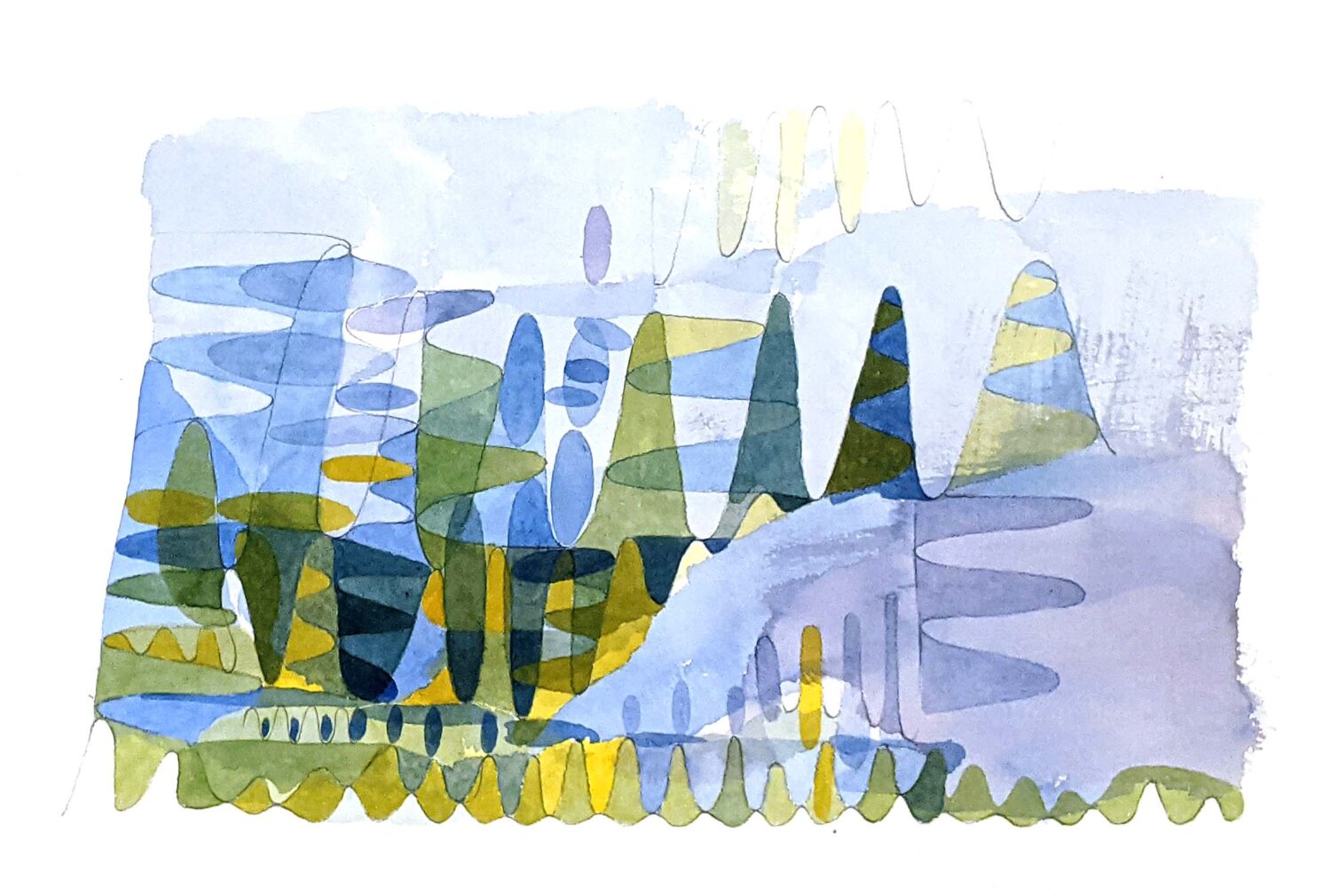The soul dives into the being of the world and ‹hears› the connections at work. When the soul moves, thinking in these contexts, its knowledge becomes a musical presence, or inspiration.
When I look at a painting, a sight unfolds before my eyes – figures, colors, and shapes. I am directly exposed to the pictorial in it. But the gaze that lingers in the picture moves between the spots of color and shapes. I gradually begin to understand the totality of relationships that have taken shape as a composition. Internally, I play the painting musically. And this playing leads me, at a certain moment of depth, to an experience that cannot be put into words. It leads me to a perception of an essence or impulse, perhaps the essential core from which the image was born. But in painting, the process is reversed. In painting, one starts from a core direction that lives as an impulse in oneself, develops it into movement – the act of painting itself is movement in space – and this movement gradually unfolds before oneself into the picture. Here, the movement leads from the core of the primer via a mediated metamorphosis to the image.
Observing this process reveals to us three activities that simultaneously constitute three different modes of consciousness: pictorial consciousness, musical consciousness, and essential consciousness itself. In Rudolf Steiner’s language: imagination, inspiration, and intuition. The mediating level, musical consciousness, tries to grasp the relationships between things and lives in the relationship as a musical interval.
In its direct, spiritual aspect, this consciousness perceives reality as music. The world appears to it as a fabric in play, as a conversation woven between the beings of the cosmos. This is the experience to which Steiner points out as belonging to the sphere of the lower Devachan. But this playful reality appears in its earthly form as human thought. What is perceived in the higher spheres as a kind of music reveals itself in its somewhat shadowy abstract form as the thought activity that creates the concepts (GA 9, p. 123). There is a key here. If we turn the thinking gaze from conceptual terms, i.e., from the content to the thinking activity, then thinking opens up to us as a movement. The action of thinking then resembles musical playing. To understand something is to play it, to participate actively in the relationships that establish it as such. How does thinking play? It creates distinctions based on similarities and differences. In this sense, logic itself is based on a musical experience. And the most basic distinction that thought makes for human beings is the distinction between ‹I› and the world.
Pulsating Movement
Only a thinking being can say ‹I› to itself. It distinguishes itself from the rest of the world and closes upon itself as an autonomous unit. This process, which develops over the millennia, reaches its experiential climax in the time of the Consciousness Soul. The self, isolated from the world, experiences itself as entirely alien to this world. This is the source of clear self-consciousness but also of the social chaos of our time. But the very activity by which separation was first created – thought – has the capacity to lead humans to a new unity. Only the key that locked the door can open it. To do this, thinking itself must undergo transformation. It must discover within itself this unifying, dynamic element.
The difficulty in developing such thinking lies in understanding reality as a movement rather than a collection of self-contained objects. Philosophical and scientific thought since ancient Greece has emphasized the analytical differentiating that focuses on individual objects and concepts, thereby creating a clarity of consciousness. But this clarity of the first stage came at the expense of the unity of life. The question posed to us by the threshold transition of our time is how we can return to a holistic, unified experience without losing the clarity of consciousness we have gained.

To answer this, we must return to the starting point of the thinking activity: only because I embrace the world in my thinking can I separate myself from it. The act of separation is based on unity. In reality, my I and the world are two aspects of the same all-encompassing unity. «Notice the pendulum swing / between humans and the world,» Steiner writes in one of his verses for meditation, «And to you reveal themselves / human-world-being / world-human-being,» and aims at a moving, musical way of thinking that begins to develop in our time.
As Georg Goelzer shows in his book ‹Der kristallene Strom› [The Crystal Stream], this pulsating movement reveals itself in crossing the thresholds of center and circumference as the transformation that makes the world an aspect of the I and the activity of the I an aspect of the world. The ‹in-between› thus reveals itself as the actual middle – it contains the poles in itself.
The beginnings of such thinking can also be seen in Martin Buber when he points to the relationship between the self and the other as a space whose reality is the relationship. For him, the ‹in-between› is the reality of the I-you relationship. In this way, thinking itself becomes dialogical and is led into the social.
Musical Consciousness
Looking at the ancient world, Pythagoras stands before us as someone who regarded the cosmos as a relational structure. One of the discoveries attributed to him is the relationship between the length of the string and the pitch. Two strings identical in their other characteristics, one half shorter than the other, produce an interval of one octave. Pythagoras discovered the mathematical relationships underlying music. The strings imitate or embody the numerical relationships, just as the stars do in their relative movements to each other. It is the embodiment of the invisible numerical ratio in visible matter. Imitation means that the same thing exists on different levels without diminishing its existence. The emphasis here is on the relationship, which can also be thought of in the sense of music: «What Pythagoras called the music of the spheres is something that the spiritual researcher can really achieve. One immerses oneself in the things and beings of the spirit world and hears, but hears by speaking. A talking hearing, a hearing speech immersed in the essence of things, is what one experiences. The real inspiration is what arises.» (R. Steiner, GA 153, p. 22)
What, then, is the ‹true inspiration›? The soul dives into the being of the world and hears the connections at work by speaking (or playing music). This perception in the spiritual spheres is, at the same time, self-action. Movement reveals itself as an inspiring, musical element between the pictorial and the intuitive.
Translation Monika Werner






grateful thanks for this wonderful work towards better comprehension of the 3 levels; often so misunderstood. I hope there are many readers who find these words, delivering freedom from misconstrued previous interpretations. Well done!
This work is both insightful and inspiring – I really like the thought that the soul inhabits that interface between sympathy and antipathy. There is a lot to meditate upon here. Thank you so much.
In the beginning was the ‘word’ and the ‘word’ was made flesh.
observation, sensation, perception, conception require NO words or language of any kind. Only in the ‘absence’ of noise, intelligent or otherwise, can the mind practice contemplation, intuition and initiate counter-intuitive action! Only thus will humans become ‘Beings’ in his likeness. Thank you for sharing insight into the art of creating without words = music!